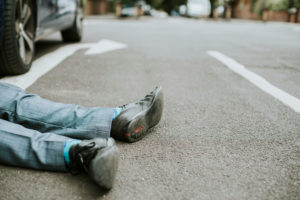
Determining liability for a “midblock accident” can be complicated, and even if there is strong evidence of liability, the defense might still dispute causation or damages. Read on for the answers to a few frequently asked questions about these claims:
1. Can a Pedestrian Be Held Liable for a Midblock Accident?
Under some circumstances, yes, a pedestrian can be held liable for a midblock accident. Simply put, if it can be shown that the pedestrian’s negligence was a proximate cause of the crash, then the pedestrian may be held partially or entirely liable.
During your initial consultation and the subsequent investigation, your attorney will try to answer the following questions regarding liability:
- Did the pedestrian break a traffic law or otherwise breach the duty of care owed to the driver, and was this breach of duty a proximate cause of the accident?
- Did the driver break a traffic law or otherwise breach the duty of care owed to the pedestrian, and was this breach of duty a proximate cause of the accident?
As you may already know, jaywalking is illegal in the state of California. Specifically, pedestrians who are on a roadway but outside of a marked crosswalk or unmarked crosswalk at an intersection must yield the right of way to vehicles that are so near as to cause an imminent hazard. That means if you entered the road midblock outside of a marked crosswalk, it is likely that you were jaywalking at the time, which would likely constitute negligence.
It is important to note, however, that even if you were in fact jaywalking, it may still be possible to recover compensation for at least some of your damages if it can be shown that the driver also breached the duty of care. For instance, if the driver was under the influence of drugs or alcohol, speeding, or distracted at the time of the accident, he or she might be at least partially liable.
2. What If Both the Pedestrian and the Driver Were Liable?
Comparative negligence laws vary by state. California uses a pure comparative negligence standard, which means that each liable party is assigned a percentage of fault. Even if the plaintiff was mostly responsible for the accident—90 percent, for example—he or she can still pursue compensation for damages, but the award will be reduced by his or her own percentage of fault.
As you can imagine, there’s a high probability for a dispute to arise in tort cases that involve shared liability. Even if there exists strong evidence of negligence, causation, and damages, the opposing party might disagree on how fault is apportioned. And if the damages are significant, a few percentage points may correspond to tens of thousands of dollars or more in damages.
If your accident involves shared liability, it is critical that you speak with a pedestrian accident attorney who has a track record of success in similar claims. Such a lawyer will likely be familiar with the statutes and case law pertaining to the imposition of liability in shared fault cases, and may therefore be able to minimize the percentage of fault assigned to you without having to enter litigation or proceed to trial unnecessarily.
3. When Might a Personal Injury Defendant Dispute “Causation?”
Causation is another element that must be proven in order to recover damages in a personal injury claim. In most pedestrian accident cases, proving causation requires the claimant to demonstrate that the defendant’s negligence was a proximate cause of the claimant’s injuries and the resulting damages.
Even if the defendant was in fact liable for the crash, a dispute over causation may still arise if the claimant is pursuing damages for the aggravation of a pre-existing injury. The defense might argue that the claimant would have incurred such damages even if the accident had not happened. To counter this defense, your attorney might use your medical records from before and after the crash, as well as the deposition of retained medical experts and your treating physician.
Another reason for a causation dispute might be the claimant’s alleged failure to mitigate damages. If, for instance, the claimant missed doctor’s appointments, returned to work too early, or otherwise failed to take reasonable steps to facilitate his or her medical recovery, the defense might assert that the claimant’s own negligence was a proximate cause of at least a portion of the damages. Here again, your attorney may use your medical records and the testimony of various medical experts and your treating physician to counter such a defense.
4. How Might a Pedestrian Accident Lawyer Prove Damages
After establishing that the defendant’s negligence was a proximate cause of the accident, your attorney will have to prove the kinds of damages you have suffered as a result of the tort (and perhaps the damages you are reasonably certain to incur in the future) as well as the value of such damages. Evidence of damages may include:
- Photos of injuries;
- The police report;
- Your medical records;
- Your financial records;
- The deposition of retained medical and financial experts;
- The deposition of your treating physician;
- The deposition of loved ones; and
- Your personal injury journal.
Discuss Your Situation with a Pedestrian Accident Attorney in Long Beach
Your Injuries Are Personal to Me
At the Law Office of Michael D. Waks, we understand how stressful the aftermath of a serious injury can be, especially when the opposing party blames you for the accident. Attorney Michael Waks can review the facts of your case, perform an investigation, and determine whether you may be entitled to compensation. For a free consultation, call (562) 206-1939 or message us online.
- How to Help Your Loved One Cope with a Spinal Cord Injury - October 27, 2021
- How Can I Prove a Motorist Fell Asleep in Traffic? - October 20, 2021
- Filing a Truck Accident Claim? Avoid These Common Mistakes - October 13, 2021